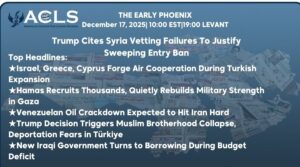
★ ISRAEL-HEZBOLLAH WAR
-
Israel’s Deepest Incursion Yet Marks New Phase in Lebanon
Hezbollah launched surface-to-surface missiles into Israel early Wednesday in response to intensified Israeli airstrikes on southern Lebanese villages. Sirens sounded across Haifa and northern Tel Aviv as Israeli interceptors engaged, while a drone reportedly struck a factory in Nahariya. In a significant escalation, Israeli forces advanced deeper into southern Lebanon near Khiam on Tuesday, marking their farthest ground incursion yet. Hezbollah retaliated with rocket and artillery fire targeting Israeli positions near Aita al-Shaab, including a Merkava tank destroyed by a guided missile.
-
Following Nasrallah, Safieddine, Qassem’s Leadership Unlikely to Last
Hezbollah announced the appointment of Naim Qassem as its new secretary-general, succeeding Hassan Nasrallah, who suffocated to death after the Israeli strike. Nasarallah’s presumed successor, Hashem Safieddine, also died of the same causes after another airstrike prior to his official appointment. Israeli Defense Minister Yoav Gallant commented on Qassem’s appointment, calling it temporary and suggesting that it would not last long.
-
Hezbollah’s Qassem Cemented Iran-Aligned Ideology in Lebanon
Naim Qassem was born in 1953 in Kfar Fila, a village in southern Lebanon. Qassem has a background in chemistry and religious studies, previously teaching at Hammana High School, east of Beirut, in Lebanon. Qassem played a significant role as part of Hezbollah’s founding leadership in promoting Iran’s Wilayat al-Faqih (Guardianship of the Jurist) model among Lebanese Shiites. This shift began in the early 1980s, shortly after Hezbollah’s founding in 1982 during the Lebanese Civil War. By the mid-1980s, Hezbollah’s alignment was firmly established, with Khomeini as its marja (religious authority) and Iran as its primary ideological and financial backer. Since the 1990s, Hezbollah has expanded Khamenei’s ideology, attracting followers through financial aid, healthcare, education, and employment opportunities. The group effectively positioned itself as a defender of Lebanon’s Shiites. Qassem, a key figure in advancing this alignment, has authored books and delivered lectures that emphasize Islamic values, Shiite identity, and Hezbollah’s strategic goals. His efforts aim to embed these ideologies deeply within Lebanese society, solidifying local support and aligning the Shiite population with Iranian-backed policies. Recent studies revealing that 73% of Lebanese Shiites align positively with Khamenei’s authority strongly affirm the impact of Qassem’s efforts. On August 24, 2023, The Early Phoenix reported that Naim Qassem said: “The Israeli entity must be wiped off the region completely, because this regime is not only a danger to the earth, but also a danger to humanity and the future.” He also said Hezbollah managed to change the equations in the region. The remarks came after Israel Hayom argued in an article that the Zionist regime’s army is incapable of taking any decision to confront the growing power of Hezbollah due to its domestic problems.
-
Israeli Forces Arrest Hezbollah Commanders in Aita al-Shaab
Israeli forces reportedly arrested Hezbollah’s Aita al-Shaab commander and several Radwan Force members, following operations by the Golani Brigade. According to Avichay Adraee’s post on the X platform, investigations with those detained led to the discovery and destruction of multiple Hezbollah targets in the region. Additionally, Israel’s 36th Division located a tunnel entrance within a Hezbollah military command center, where acting commander Hassan Aqil Jawad was captured. All detainees are being held in Israel for continued investigation.
-
Hezbollah Barrage Rockets On Israel’s North, Kills One
Drone launches from Lebanon and Yemen triggered explosions in Nahariya and Ashkelon, with a subsequent barrage of 50 rockets striking Ma’alot-Tarshiha. The assault resulted in the death of local resident Muhammad Naim.
-
Injury of Eight Austrian UNIFIL Soldiers in Lebanon
The Austrian Ministry of Defense reported that eight Austrian soldiers from UNIFIL were injured in a rocket attack in Naqoura. Fortunately, there were no serious injuries, and the source of the attack remains unclear. The ministry condemned the incident, emphasizing that it is unacceptable to endanger United Nations forces. Additionally, UNIFIL soldiers have faced multiple gunfire incidents in recent days.
-
Israel Warns Residents of 16 Towns in Southern Lebanon to Evacuate
The Israeli army has warned residents of 16 southern Lebanese towns to evacuate due to troop incursions. Tanks have reached Khyam’s outskirts, with spokesman Avichai Adraee urging residents to head toward the River Awali for safety. Violent clashes erupted between Hezbollah fighters and Israeli armored forces, while airstrikes targeted Khyam and nearby towns.
-
Hochstein Tags McGurk to Join Lebanon Ceasefire in Israel
Facing stalled negotiations, Amos Hochstein has enlisted Brett McGurk to join his diplomatic efforts in Israel to secure a ceasefire with Hezbollah before the U.S. election cycle intensifies. After a week in Beirut without progress, Hochstein’s urgent call to McGurk underscores a mounting pressure on the Biden administration to finalize any agreement that could stabilize Lebanon and counter negative headlines impacting the Harris campaign. Sources indicate that the plan under discussion includes full implementation of UN Resolution 1701, calling for Lebanese army deployment in the south and Hezbollah’s withdrawal north of the Litani River. Israeli officials see the U.S. involvement as a signal of Netanyahu’s willingness to negotiate, though concerns remain high as Lebanese authorities insist on reinforcing UNIFIL’s presence in the region. Meanwhile, Hochstein’s rushed departure from Washington this Sunday reflects the Biden team’s scramble to broker peace in Lebanon, hoping to solidify foreign policy gains that could appeal to American voters.
-
Nasrallah’s Nurse’s Body Recovered 32 Days After Israeli Strike
Thirty-two days after Israeli airstrikes killed Hezbollah Secretary-General Hassan Nasrallah in Beirut’s southern suburbs, the body of his nurse, Muhammad Khalil Khreis, was retrieved from the rubble. Local reports confirm that Khreis was with Nasrallah on September 27, when Israeli aircraft dropped over 80 bunker-busting bombs on a fortified site in Haret Hreik, leading to Nasrallah’s death from suffocation in the lower levels of the building.
==========
★ IRAN
-
Iran and Israel Warn of Intensified Military Strikes
Iran’s Revolutionary Guard warned of stronger strikes against Israel, following Israeli airstrikes on missile production sites and air defenses inside Iran. IDF Chief Herzi Halevi pledged harsher retaliation if Iran launches further attacks, emphasizing that Israel retained advanced capabilities for future use. Meanwhile, Iran’s Deputy for Coordination, Mohammad Reza Naqdi, warned of imminent retaliation. Iran’s Supreme Leader, who controls final military decisions, has yet to reveal Iran’s ultimate course of action.
-
Berlin Summons Iranian Diplomatic Head Over Execution of Jamshid Sharmahd
The German Foreign Ministry announced Tuesday that it summoned Iran’s chief diplomatic envoy in Berlin to protest the execution of dual German-Iranian citizen Jamshid Sharmahd, according to the German News Agency. On Platform X, the ministry stated, “We conveyed our strong protest over the actions of the Iranian regime and reserve the right to take further steps.” In parallel, the German ambassador in Tehran lodged a strong protest with Iran’s Foreign Minister over Sharmahd’s “killing.” German Foreign Minister Annalena Baerbock also recalled Ambassador Markus Potzel to Berlin for consultations.
-
Iran Approves 200% Military Budget Increase, Tripling Spending
Iran is set to triple its military budget by 200% in response to rising regional tensions and recent Israeli airstrikes, despite an economic crisis and depreciating currency. The budget for 2025–2026, amounting to $105 billion, relies heavily on oil and gas revenues, which face losses due to U.S. sanctions. Oil revenues fund both the government and Iran’s armed forces, whose share in oil exports has quadrupled. Tehran plans tax hikes and increased borrowing to cover an expected deficit, risking further inflation and public discontent.
-
Iran’s Oil and Gas Condensate Production Rises 8% in Q3 2024
Iran’s Oil Ministry reported an over 8% increase in crude oil and gas condensate production in Q3 2024 compared to the same period last year, despite U.S. sanctions. According to Iran’s IRNA agency, multiple international organizations noted Iran’s increased global share in crude oil production, over six years since the U.S. exited the nuclear deal. Earlier this month, OPEC’s latest report indicated that Iran produced 3.316 million barrels of crude oil daily in September, marking an increase of 21,000 barrels per day from the previous month.
-
Iran Strengthens Trade Alliances with Uzbekistan and China
Iranian state media reported growing trade partnerships with Uzbekistan and China, emphasizing resilience against Western sanctions. Tasnim Agency claims that Iran and Uzbekistan plan a preferential trade agreement, aiming for $5 billion in annual trade. Iranian officials announced a joint investment fund and the 16th Joint Economic Committee in March to solidify economic ties. Separately, Tehran Times quoted China’s Ambassador Kong Piu affirming China’s commitment to enhance trade in all sectors, with Iranian officials claiming trade is at its highest. Both developments are portrayed as strategic partnerships to counteract U.S. and European pressures.
============
★ ISRAEL-HAMAS WAR
-
Jabalia Operation Neutralizes 60 Fighters, Evacuates 50,000 Civilians
The IDF’s surprise operation in Jabalia camp, northern Gaza, led to the surrender of 60 Hamas fighters. IDF forces targeted the Kamal Adwan Hospital, capturing senior operatives and disrupting Hamas’s stronghold. An estimated 50,000 civilians were evacuated, while reports allege the IDF burned Al-Fakhoura school, killing 36. Israeli airstrikes on Tuesday killed at least 143 Palestinians across Gaza, including 132 in northern regions. In Beit Lahiya, a strike demolished a five-story building sheltering displaced families, resulting in numerous casualties, including children. About 40 people remain missing following the attack on the Abu Nasr family home. Civil Defense spokesman Mahmoud Basal confirmed numerous civilian injuries. The building housed displaced individuals from Jabalia camp.
-
12,000 Israeli Soldiers Enter Rehabilitation Since October 7 Conflict
Since the start of Israel’s war against Hamas on October 7, 2023, approximately 12,000 soldiers and security personnel have entered rehabilitation. The Israeli Defense Ministry reports that 66% are reservists, with 93% men aged 18 to 30. Injuries in northern Israel surged by 150% in October, leading to 910 hospital evacuations. About 5,200, or 43%, suffer from PTSD. Despite a budget increase to 7.3 billion shekels, the department head calls for additional funding to meet needs.
-
Sixteen Nations Condemn Israeli Law Restricting UNRWA Operations
Sixteen nations, including Algeria, Belgium, and Brazil, condemned Israel’s recent legislation limiting UNRWA’s operations, describing it as a violation of international law. The joint statement, presented at the UN Security Council, highlighted concerns that this law will obstruct Gaza’s humanitarian response, heavily dependent on UNRWA’s support. The Knesset recently passed bills barring UNRWA from Israel and restricting its activities in Gaza and the West Bank, preventing Israeli authorities from coordinating with the agency and making operations difficult without government cooperation.
-
Israel Announces Death of Four Soldiers in Operations North of Gaza
Israel confirmed that four soldiers, including a unit officer, were killed during operations in Jabalia, northern Gaza. Details of their deaths remain unclear during escalating bombardments. Medical sources reported 115 deaths from airstrikes on Gaza since dawn, with 109 casualties in the northern sector.
-
Pentagon Missile Stockpile Depletes as Military Tensions Escalate
The United States faces a significant shortage of air defense missiles, raising concerns about military readiness during escalating tensions. Demand for interceptor missiles has surged due to the ongoing confrontation between Israel and Iranian forces. This shortage worsened after Israeli strikes on Iran, increasing fears of retaliatory attacks. Since October 2023, the U.S. has launched over 100 Standard missiles, while challenges in increasing production arise from the need for new production lines.
===========
★ YEMEN
-
Yemen’s Houthis Launch Drones Toward Ashkelon, Israel
Yemen’s Houthi forces launched drones targeting an industrial zone in the Israeli city of Ashkelon, according to the group’s military spokesperson. The Israeli military confirmed that sirens were triggered in Ashkelon after a drone entered Israeli airspace, eventually landing in an open area without causing damage.
===========
★ SYRIA
-
Israeli Airstrikes Hit Military Sites in Syria’s Daraa
Assad media reported explosions in Tel al-Jabiyah, western Daraa, believed to be Israeli airstrikes. Local sources confirmed that the strikes targeted military sites northwest of Daraa and agricultural areas in southern Quneitra.
-
Assad Regime Detains, Tortures Refugees Returning From Lebanon
The Assad regime detained 26 refugees returning from Lebanon, with reports confirming the death of one under brutal torture. Forced to choose between hardship and danger, some refugees return to Syria, only to face detention, torture, and even death under the Assad regime’s oppressive rule.
===========
★ TURKIYE
-
Turkish and U.S. Defense Chiefs Discuss Escalation Against Syrian Forces
Turkish Defense Minister Yasar Guler and U.S. Defense Secretary Lloyd Austin engaged in high-level talks concerning security dynamics and Türkiye’s recent intensification of military operations against Syrian Democratic Forces (SDF) in northern and eastern Syria. Türkiye’s escalated air and ground offensives, in response to a recent Kurdistan Workers’ Party (PKK) attack targeting a Turkish aerospace facility, have raised strategic concerns. Meanwhile, U.S. forces have heightened their patrols around critical oil fields in eastern Syria, closely monitoring developments amid shifting regional security parameters.
===========
★ IRAQ
-
Qatar, Iraq Solidify Economic Endeavors, Reflecting Strengthened Relations
QatarEnergy and Iraq’s TotalEnergies will co-develop a 1.25-gigawatt solar project under Iraq’s Gas Growth Integrated Project (GGIP). With each company holding a 50% stake, the project will provide power to 350,000 Basra homes, using 2 million bifacial solar panels on single-axis trackers. Phased from 2025 to 2027, the initiative marks QatarEnergy’s deeper collaboration with Iraq following its GGIP involvement in June 2023.
===========
★ GULF NATIONS
- Saudi Arabia Reaffirms 12.3 Million Barrels Daily Oil Production
Saudi Energy Minister Prince Abdulaziz bin Salman confirmed the Kingdom’s commitment to maintaining an oil production capacity of 12.3 million barrels per day. He emphasized that Saudi Arabia, the world’s largest oil exporter, aims to balance its climate goals with its production strategy. Current production is below 10 million barrels per day, focusing on renewable energy projects and hydrogen exports. Oil prices have risen slightly due to concerns about weak demand growth in the market.
- Saudi Arabia and Spain Agree to Build Three Ships
The Saudi Ministry of Defense signed an agreement in Madrid with the Spanish Ministry of Defense to construct three Avante 2200 corvettes. This agreement aims to enhance cooperation in training, technical support, and logistics for the Royal Saudi Navy. The new ships will bolster the Navy’s readiness to protect national interests and enhance maritime security. The partnership also supports Saudi Vision 2030’s goal of localizing 50% of military industries within the Kingdom.
==========



